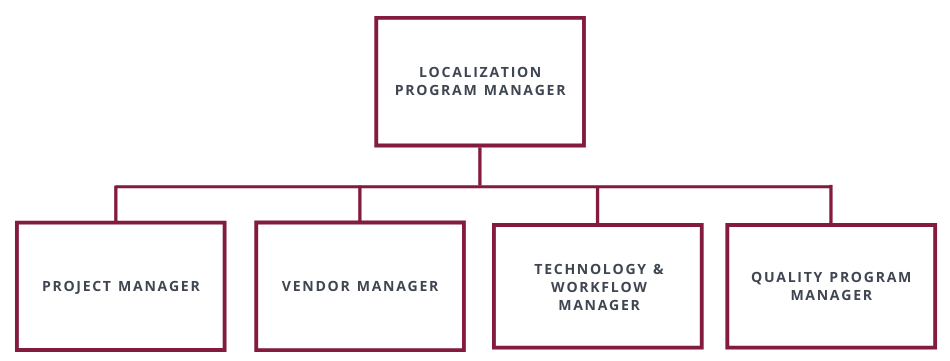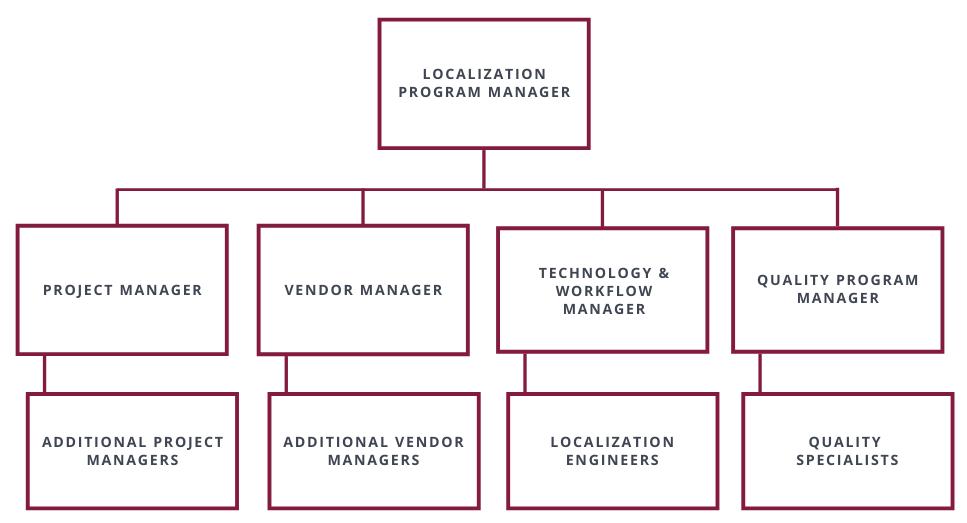Building Your Localization Dream Team

You’ve come a long way in making localization a strategic function of your global business. You have the essential localization processes set up with some metrics and KPIs in place. Solid results have awarded you internal buy-in, dedicated budget, increased sales and customer satisfaction. Everything is going great, until…the growing pains begin.
When growth involves things like higher volumes, different content types and faster time-to-market, teams get overburdened. Today’s increasing size and speed of localization means existing roles must change or new roles need to be added.
At some point, you might have to consider outsourcing your whole localization program. But in this middle ground of localization maturity, there are compelling reasons to build an in-house localization team. As long as you have a steady flow of work, in-house tech and a solid quality control infrastructure in place, in-house loc might offer you the most control at the lowest cost.
But one reason some organizations struggle to set up a truly strategic in-house localization operation is because they lack a formal team structure—which you need in order to maximize speed, scale more easily and achieve consistent quality.
So, let’s talk about what this structure should look like. Who makes up a localization Dream Team?
Localization team roles
Your localization program should consist of at least five essential divisions:
- Program guidance: Top-level oversight of the entire operation.
- Production: The creation and delivery of localized products and experiences.
- Resource oversight: To manage and support the personnel needed to complete production.
- Support infrastructure: The processes, tech and other resources needed to streamline production.
- Quality oversight: To ensure the quality and consistency of localized products and experiences.
These represent the five functions that must be present in every loc team. If yours is currently non-existent, the first step is to hire an individual to oversee each division.
Here’s a quick look at each role and its responsibilities.

Localization program manager
Responsible for: the success of the overall localization program.
This is the person to whom all other team members report. The localization program manager owns localization strategy. Their goal is to guarantee the efficient and successful launch of products and services internationally while improving processes and workflows to continually improve quality and scale.
Related responsibilities include:
- overseeing the strategy of the program: the planning and execution of international launches, budgeting and continuous improvement
- managing internal customer satisfaction: collaborating cross-functionally with key stakeholders (content, product, design and engineering teams, for example) and reporting activities and outcomes to them
- evangelizing localization to upper management and educating internally on globalization best practices
Localization project manager
Responsible for: localization production and delivery.
Project managers are the link between stakeholders and vendors and the main contact for day-to-day project activities.
It’s their responsibility to deliver the work. That means:
- sourcing and assigning the right linguists and other necessary resources to projects
- placing projects in the appropriate workflows
- managing timelines and capacity
- equipping resources with the tools, documentation and training they need
- monitoring projects to ensure on-time delivery
- reporting status to stakeholders and leading status meetings
The job comes with the standard project management functions you would expect, including status and financial reporting, workload planning and project-level forecasting. Localization project managers report both internally and to the client.
Localization vendor manager
Responsible for: vendor relations.
It’s this role’s job to manage relationships with any external language partners you work with. These could be freelance translators, localization technology consultants or language service providers—in increasing numbers as you scale (more on that later).
The role encompasses everything from sourcing to price negotiations to training and onboarding, with a view to balancing localization quality with financial efficiency. Key responsibilities include:
- vetting and hiring freelancers and vendors
- managing vendor billing and invoicing
- supporting PMs by matching vendors to projects based on capacity, expertise and performance
- collaborating with vendors on strategic innovation
Localization technology and workflow manager
Responsible for: the localization support infrastructure.
Workflow automation has mercifully replaced the cumbersome practice of managing localization projects in spreadsheets and emails—removing localization managers from their role as middlemen and encouraging team collaboration. As a result, the technology and workflow management role has emerged in recent years to support two key elements of localization:
- Buying and managing the technologies: selecting, implementing, configuring and maintaining the tools needed to automate workflows—a core stack that can consist of a translation management system (TMS), integrated machine translation (MT) and linguistic assets like glossaries.
- Designing and managing the workflows: with the goal of keeping the program running efficiently, cost-effectively and at speed. This includes training team members on using the technology and providing tech support.
Localization quality program manager
Responsible for: overseeing localization quality.
This role owns the quality program, an effort to establish and ensure high localization standards. It involves:
- Quality strategy: working with vendors to develop the localization quality assurance (LQA) framework the team uses to ensure consistent, on-brand, repeatable delivery of high-quality localization.
- Quality evaluation: managing and tracking linguistic quality via clearly defined metrics, driving efforts to improve quality measures and feedback loops and establishing best practices for maintaining high quality.
- Facilitating efficient team collaboration: gaining agreement on quality objectives, communicating quality issues to key stakeholders while driving clarity around ownership and managing project objectives and tasks with many stakeholders and moving parts.
Scaling your localization team
Now that you know the basic structure of the team, you can scale it as you grow, building out each division vertically. For example:

When you’ve outgrown in-house
Though your company’s localization program needs to be large enough for in-house localization management to be practical, this approach can break down when you surpass a few target languages. In-house loc is ironically unfit for companies that are too large: there’s only so far you can scale before volume and quality become too difficult to manage internally.
That’s when you’ll need to consider a localization outsourcing strategy. With a strong foundation in your in-house team and processes, external resources can help you scale up even further. What you might lose in control and cost savings you can gain in sustainability in the long term.
Where are you in your localization strategy? In the midst of building your localization dream team or ready to outsource? Get in touch if you need some direction.

